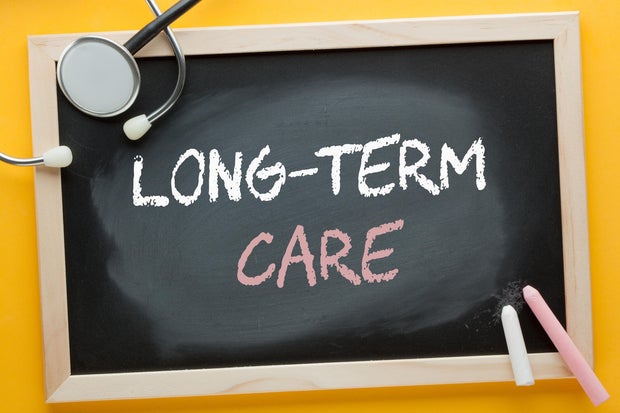 Long-term care insurance isn't a universal solution, but it makes sense for seniors to consider it right now.
OGNYAN CHOBANOV/Getty Images
Long-term care insurance isn't a universal solution, but it makes sense for seniors to consider it right now.
OGNYAN CHOBANOV/Getty Images
Planning for retirement isn't just about how much you've saved. It's also about how you'll handle the expenses you can't fully predict. And, one of the biggest unknowns for older Americans today is the cost they'll face when it comes to long-term care. While it's increasingly common for seniors to need this type of care at some point during retirement, the costs of long-term care can vary drastically depending on the type of care you need, the duration and even the market where you're receiving the care.
Further complicating the issue is the fact that the price of long-term care has been climbing. That trend is almost certain to continue, too, so it's unlikely that seniors will get relief from falling healthcare costs in the future. That makes it important to come up with a plan to cover these costs now. That's why some seniors are taking a closer look at long-term care insurance, which is intended to help cover the costs of long-term care as you age.
However, the decision on whether to purchase this type of coverage isn't always simple. Premiums can be steep, policies vary and timing matters. So, is long-term care insurance actually worth getting this fall? Below, we'll detail what to consider now.
Learn how to protect your retirement savings with long-term care insurance.
Is long-term care insurance worth getting this fall?
Long-term care insurance is designed to cover services that most people will eventually need but few can easily afford on their own. These policies help protect retirement savings from being depleted by care expenses and provide families with more flexibility when choosing how and where care is delivered. And, there are several reasons it makes sense to consider this type of policy this fall, in particular, including:
Rising senior care costs are stretching retirement budgets
According to Genworth's Cost of Care Survey, the median annual cost of a private room in a nursing home is now well above $120,000 per year for 2025. Assisted living comes with an average cost of over $72,000 annually, while in-home health aide services run over $80,000 per year on average. Even adult day health care, typically the least expensive option, has risen to more than $26,000 per year.
Those numbers are expected to continue trending upward, too. For example, Genworth's data shows that the cost of a private room in a nursing home is expected to climb to over $143,000 per year by 2028 and is estimated at over $171,000 annually in 2035 — just 10 years from now. Health care costs also tend to grow faster than the overall rate of inflation, meaning retirees who base their budgets on average inflation assumptions could be caught off guard.
And, with interest rates just starting to move lower after the Fed's recent cut, many households will soon be earning less on safe investments like certificates of deposit (CDs) and savings accounts. That gap between rising care costs and softer income growth makes long-term care insurance more attractive for those trying to shield their retirement savings.
Learn more about the long-term care insurance options available to you now.
Medicare won't cover what you think it will
Another factor to consider right now is the limited role of Medicare. Many people assume Medicare will pay for long-term services, but the reality is that Medicare only covers short-term skilled nursing or rehab care after a hospital stay. And, even then, coverage is capped at 100 days. Beyond that, seniors are expected to pay out of pocket.
That's significant when you consider the odds. The Department of Health and Human Services estimates that about 70% of Americans age 65 and older will need some type of long-term care in their lifetime. Without insurance, families often face two choices: paying directly from their savings or spending down assets until they qualify for Medicaid. For middle-income retirees, neither option is ideal.
The gap widens further when considering the type of care most seniors actually need. Most long-term care is not considered medical care but rather custodial care, which assists with common activities of daily living like bathing, dressing and meal preparation. Medicare simply doesn't cover these essential services. A long-term care policy can help bridge the gap.
It's easier to secure coverage before health issues arise
Timing matters a great deal when it comes to long-term care insurance. Unlike Medicare or Medicaid, long-term care insurance is medically underwritten, meaning insurers determine what seniors pay for this type of coverage based, in large part, on their health. Age also plays a major role, with premiums rising substantially the longer you wait to purchase coverage.
Getting approved for coverage can also be a hurdle. Nearly half of applicants in their early 70s are denied coverage, for example. And, among those approved, the premiums are substantially higher for older applicants. That means waiting until health issues arise could make it difficult or impossible to secure coverage.
So, for seniors currently in good health, this fall may be an opportune time to apply. By locking in coverage now, you can help protect your assets while the premiums are still within reach.
The bottom line
Long-term care insurance isn't a universal solution. For some, the premiums may outweigh the potential benefits, especially if family members are available to provide care or if assets are limited enough to qualify for Medicaid eventually. But for retirees with significant savings to protect — or those who want to preserve financial independence and reduce the burden on loved ones — the case for considering coverage has grown stronger, especially when it comes to purchasing a policy this fall.
Angelica Leicht is the senior editor for the Managing Your Money section for CBSNews.com, where she writes and edits articles on a range of personal finance topics. Angelica previously held editing roles at The Simple Dollar, Interest, HousingWire and other financial publications.


















































